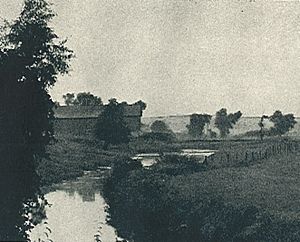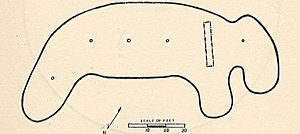Walker-Hooper Site facts for kids
Quick facts for kids Walker-Hooper Site (47-GL-65) |
|
|---|---|
 |
|
| Location | in Green Lake County, Wisconsin |
| Area | 60 acres |
| Lua error in Module:Location_map at line 420: attempt to index field 'wikibase' (a nil value). | |
The Walker-Hooper Site (47-GL-65) is a multicomponent Prehistoric site complex located on the Grand River in the Upper Fox River drainage area in Green Lake County, Wisconsin. It consisted of at least 2 village sites and several mound groups (all of which are destroyed today). It was excavated by S.A. Barrett under the auspices of the Milwaukee Public Museum in 1921 and again in 1967 by Guy Gibbon of the University of Wisconsin-Milwaukee. The major component of the site is an Upper Mississippian Oneota palisaded village. Other components were also present, mainly Late Woodland but also including Archaic, Early Woodland and Middle Woodland.
Site Environment
The site is located in the Carolinian Biotic Province as defined by Cleland. The environment of the immediate site surroundings included prairie, oak-hickory forest and marshland.
Summary of 1921 Excavations
The 1921 excavations focused on the burial mounds present on the site. There were at least 6 groups of mounds, and a total of 38 burials were recovered. Mound 1 of Mound Group 4 was interesting in that it was shaped in the form of a bear effigy.
Of the 38 burials, 23 were flexed, 8 were extended and 7 were indeterminate due to poor preservation or disturbance. The adults were almost all flexed, while the extended burials were generally infant or child burials. Grave goods were present in some burials, including pottery vessels and other artifacts. Some burials contained charcoal, implying a fire was built as part of the burial ceremony.
In addition, several “camp sites” and refuse pits were excavated, which contained animal bone, pot sherds, shell fragments and stone and bone tools and fragments.
The following artifacts were recovered from the 1921 excavations:
- Chipped stone - only a quartzite projectile point was reported, which was included in a burial
- Ground stone - including an adze, a spade and fragmentary celts and axes
- Bone and antler - including a bear tusk pendant, phalangeal bone pendant, bone awls, bone beads, a harpoon, fish hooks, antler flakers, scrapers and an antler projectile point
- Shell - including unio shell pendants and shell spoons
- Copper - including a bracelet, beads, a serpent-shaped pendant, an awl and a celt
Some of these artifacts are illustrated and discussed further below.
Summary of 1967 Excavations
The 1967 excavations yielded 2 rows of post molds interpreted as palisades; 2 oval-shaped houses; sheet middens; and 66 cache and refuse pits containing cultural debris such as pot sherds, lithic debitage and animal bone.
The houses measured 35 x 10 feet and 20 x 11 feet. Similar houses at the Huber Phase sites of Anker and Oak Forest in the Chicago area measured from 25–55 feet wide by 12–15 feet wide. The cache and refuse pits were located both within and outside the structures, although the ones outside structures tended to be larger.
The following artifacts were recovered from the 1967 excavations:
- Chipped stone - including 93 projectile points (including 78 triangular Madison points), 13 wedges, 6 gouges, 29 notched flakes, 9 gravers, 19 bifacial knives, 2 Kolterman indented-base knives, 5 small ovate knives, 12 end scrapers and 6 side scrapers
- Ground stone - including 16 hammerstones, 1 anvil, 1 pottery polishing pebble, 8 grinding stones, 2 ground stone pendants, 4 hoes, 4 paint stones and 5 adzes
- Bone and antler - including 6 antler projectile points, 13 deer tine flakers, 4 beaver incisor chisels, 5 bone punches, 4 deer metapodial awls, 4 deer scapula awls, 1 canine ulna awl, 1 bird bone awl, 8 flat splinter awls, 6 deer jaw sickles, 7 cannon bone beamers, 1 deer humerus gouge, 2 human tooth pendants, 1 canine tooth pendant and 3 bird bone tubes/ornaments
- Shell - including 4 fishing lures, 11 shell scrapers and 6 shell spoons
- Copper - including 4 pendants
- Pottery sherd - 12 pottery sherd discs similar in temper and paste to the Oneota pottery found on the site
- Clay - 1 clay spoon, 1 fragmentary clay smoking pipe and 1 ear spool
Some of these artifacts are illustrated and discussed further below.
Grand River Focus
The Walker-Hooper site is the type site of the Grand River Focus of the Oneota Aspect, based primarily on details of the pottery. In particular, the Grand River Focus pottery tends to have more plain undecorated vessels (other than lip decoration) and handles are very rare. Punctate decoration is also particularly rare. Besides the pottery, Grand River sites are also more often associated with burial mounds.
Along with the Koshkonong and Green Bay Foci, the Grand River Focus is considered part of the Developmental Horizon of the Oneota Aspect, dating to approximately A.D. 1000-1300. The radiocarbon dates obtained from the Walker-Hooper site accordingly range from A.D. 1200-1240. The site is thought to have been occupied during a relatively short interval. Based upon the animal and plant remains, it is thought to have been a summer seasonal agricultural village.




